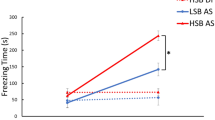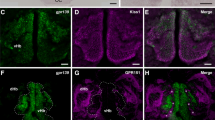Abstract
The zebrafish dorsal habenula (dHb) shows conspicuous asymmetry in its connection with the interpeduncular nucleus (IPN) and is equivalent to the mammalian medial habenula. Genetic inactivation of the lateral subnucleus of dHb (dHbL) biased fish towards freezing rather than the normal flight response to a conditioned fear stimulus, suggesting that the dHbL-IPN pathway is important for controlling experience-dependent modification of fear responses.
This is a preview of subscription content, access via your institution
Access options
Subscribe to this journal
Receive 12 print issues and online access
$209.00 per year
only $17.42 per issue
Buy this article
- Purchase on Springer Link
- Instant access to full article PDF
Prices may be subject to local taxes which are calculated during checkout


Similar content being viewed by others
Change history
17 October 2010
In the version of this article initially published online, there was an error on page 2, right column, second paragraph, 14th line. Here, ‘Mtz’ should read ‘metronidazole’. The supplementary material file was also missing some information from the images. Both errors have been corrected for the print, PDF and HTML versions of this article.
References
Hikosaka, O. Nat. Rev. Neurosci. 11, 503–513 (2010).
Bianco, I.H. & Wilson, S. Phil. Trans. R. Soc. Lond. B 364, 1005–1020 (2009).
Herkenham, M. & Nauta, W. J. Comp. Neurol. 187, 19–47 (1979).
Ressler, K.J., Paschall, G., Zhou, X. & Davis, M. J. Neurosci. 22, 7892–7902 (2002).
Amo, R. et al. J. Neurosci. 30, 1566–1574 (2010).
Aizawa, H. et al. Curr. Biol. 15, 238–243 (2005).
Wullimann, M.F., Rupp, B. & Reichert, H. Neuroanatomy of the Zebrafish Brain: A Topological Atlas. (Birkhäuser, Boston, 1996).
Bandler, R., Keay, K., Floyd, N. & Price, J. Brain Res. Bull. 53, 95–104 (2000).
Goto, M., Swanson, L. & Canteras, N. J. Comp. Neurol. 438, 86–122 (2001).
Reti, I.M., Reddy, R., Worley, P. & Baraban, J. J. Neurochem. 82, 935–944 (2002).
Sweeney, S.T., Broadie, K., Keane, J., Niemann, H. & O'Kane, C. Neuron 14, 341–351 (1995).
Eisenberg, M., Kobilo, T., Berman, D. & Dudai, Y. Science 301, 1102–1104 (2003).
Curado, S. et al. Dev. Dyn. 236, 1025–1035 (2007).
Mongeau, R., Miller, G., Chiang, E. & Anderson, D. J. Neurosci. 23, 3855–3868 (2003).
Maier, S.F. & Watkins, L. Neurosci. Biobehav. Rev. 29, 829–841 (2005).
Acknowledgements
We thank Y. Yoshihara, T. Koide and other members of the Yoshihara laboratory for transgenic fish and advice on the behavioral experiments, S. Watanabe for help in setting up the behavioral experiments, N. Copeland for the BAC homologous recombination system, S. Fraser for GAL4VP16 and UAS plasmids, M. Parsons for the UAS:nfsB-mCherry plasmid, A. Thomson for correction of the manuscript and S. Jesuthasan for communication of unpublished data. We are grateful to all of the members of the Okamoto laboratory for support and advice, the Research Resource Center of RIKEN BSI for animal care and the National BioResource Project of Japan for fish strains. This work was supported by Grant-in-Aids from the Ministry of Education, Culture, Sports, Science and Technology of Japan to H.O. and H.A. and by the Core Research for Evolutional Science and Technology of Japan Science and Technology Agency to H.O.
Author information
Authors and Affiliations
Contributions
M.A., H.A. and H.O. designed the experiments and wrote the manuscript. H.O. supervised the research project. M.A. performed most of the experiments using transgenic fish with T.A., R.N., M.T., T. Sassa, T. Shiraki, K.K., T.H. and S.H. H.A. performed the neural tracing study with M.G., M.T. and R.A.
Corresponding author
Ethics declarations
Competing interests
The authors declare no competing financial interests.
Supplementary information
Supplementary Text and Figures
Supplementary Figures 1–24, Supplementary Table 1, Supplementary Methods and Supplementary Data (PDF 4168 kb)
Supplementary Movie 1
Response of the control fish at the first trial of the retrieval session. (MOV 494 kb)
Supplementary Movie 2
Response of the dHbl-silenced fish at the first trial of the retrieval session. (MOV 1138 kb)
Supplementary Movie 3
Persistent rotation of the dHbl-silenced fish at the first trial of the retrieval session. (MOV 581 kb)
Rights and permissions
About this article
Cite this article
Agetsuma, M., Aizawa, H., Aoki, T. et al. The habenula is crucial for experience-dependent modification of fear responses in zebrafish. Nat Neurosci 13, 1354–1356 (2010). https://doi.org/10.1038/nn.2654
Received:
Accepted:
Published:
Issue Date:
DOI: https://doi.org/10.1038/nn.2654
This article is cited by
-
Computational modeling of light processing in the habenula and dorsal raphe based on laser ablation of functionally-defined cells
BMC Neuroscience (2024)
-
Social and asocial learning in zebrafish are encoded by a shared brain network that is differentially modulated by local activation
Communications Biology (2023)
-
Activation of lineage competence in hemogenic endothelium precedes the formation of hematopoietic stem cell heterogeneity
Cell Research (2023)
-
Novel non-stimulants rescue hyperactive phenotype in an adgrl3.1 mutant zebrafish model of ADHD
Neuropsychopharmacology (2023)
-
Neural Circuit Mechanisms Involved in Animals’ Detection of and Response to Visual Threats
Neuroscience Bulletin (2023)



